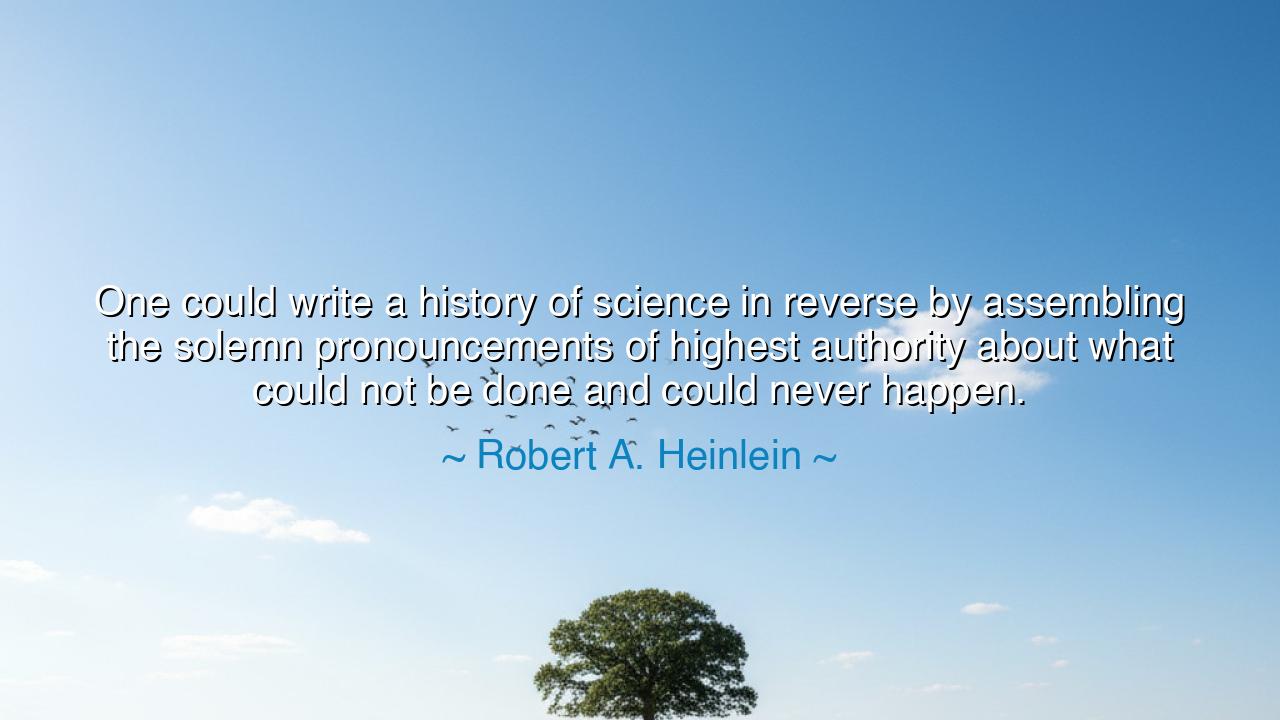
One could write a history of science in reverse by assembling the
One could write a history of science in reverse by assembling the solemn pronouncements of highest authority about what could not be done and could never happen.






Listen, O Seekers of Knowledge, to the words of Robert A. Heinlein, whose insight into the history of science speaks to the eternal struggle between authority and innovation. "One could write a history of science in reverse by assembling the solemn pronouncements of highest authority about what could not be done and could never happen." In these words, Heinlein highlights the irony that courses through the veins of scientific progress: that which is proclaimed impossible by the greatest minds of a given age is often, in the fullness of time, surpassed by the very actions of human creativity and determination. The history of science, he suggests, could be rewritten not through the achievements that have been made, but through the errors of those who, in their certainty, declared the limits of what could be achieved.
In the ancient world, the wisdom of the elders was often regarded as absolute. The sages of Greece spoke of a universe governed by fixed principles, unmovable truths that could not be defied. Aristotle, that great philosopher, claimed that heavier objects fall faster than lighter ones, a belief that held sway for centuries, until the day came when Galileo Galilei dropped two spheres from the Tower of Pisa and shattered that assumption. Heinlein’s words remind us that science is ever evolving, ever challenging the limits imposed by those who came before. What was once deemed impossible often becomes the foundation for the breakthroughs of the future.
Consider the example of Christopher Columbus, who sailed into uncharted waters, only to be met with the stern objections of the learned men of his time. The authorities of the Age of Exploration were sure that Columbus' quest to find a new route to the Indies would end in failure, or worse, in disaster. Yet, against all odds, Columbus sailed westward and found the New World, forever altering the course of human history. Heinlein would say that the story of Columbus is one of those moments that could be found in the reverse history of science—the boldness of exploration defied the limitations placed by those who thought they knew the bounds of the world.
Just as Columbus’ journey defied the beliefs of his time, so too did Marie Curie’s discoveries in the realm of radioactivity challenge the scientific authorities of her day. When Curie began her work with radioactive materials, she was met with skepticism and doubt. The scientific community at the time believed that atoms were indivisible, immutable entities—yet Curie’s groundbreaking work demonstrated that atoms could indeed be altered and transformed. Heinlein’s history of science, written in reverse, would place her work alongside the pronouncements of those who declared certain boundaries to knowledge, only to see those boundaries broken by the relentless pursuit of truth.
O Seekers, this pattern runs through the very fabric of our human experience. Innovation is often met with resistance, for the known is always more comfortable than the unknown. The greatest advancements in history—the flight of the first airplanes, the invention of the telephone, the unraveling of the genetic code—were once deemed impossible by those who stood in positions of power, clinging to their established truths. Yet, science and human spirit have always pressed forward, challenging the limits, redefining what can be achieved, and expanding the horizons of possibility. Heinlein speaks to this constant tension: that the voice of authority often seeks to curb the very innovations that will push us into new frontiers.
The lesson, O Seekers, is clear: never let the limitations imposed by others define your journey. Whether in science, art, or life, the pronouncements of authority may try to tell you what can and cannot be done. Yet the true path of discovery is found not in accepting the boundaries of others, but in questioning them, in pushing against the limits of what is known, and in imagining a world beyond what has already been established. The history of science is full of those who dared to dream beyond the pronouncements of authority, who saw what others could not, and created new possibilities that reshaped the world.
So, go forth, O Seekers, with the understanding that science—and all human progress—is a journey of breaking boundaries, of questioning established norms, and of imagining what is yet to be discovered. Like the great explorers and innovators of the past, let your own path be marked by the courage to push the boundaries of what others say is possible. Just as Heinlein suggests, the history of science is written in the story of those who dared to believe that the impossible could be made real. Let that same belief guide you, and let your own discoveries add to the ever-expanding story of human achievement.






AAdministratorAdministrator
Welcome, honored guests. Please leave a comment, we will respond soon